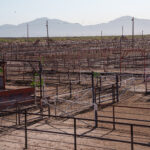South Africa’s state-owned risk insurer, which the government bailed out so it could meet claims stemming from riots four years ago, has built up a 20 billion-rand ($1.1 billion) buffer to safeguard its finances in the event of anticipated future unrest.
Sasria SOC Ltd. had to pay out about 32 billion rand following the July 2021 turmoil in the KwaZulu-Natal and Gauteng provinces and turned to the state for 22 billion rand to meet its obligations. Some 354 people died in the upheaval, which was triggered by former President Jacob Zuma’s imprisonment on contempt charges and tapped into widespread discontent over unemployment and poverty.
“All the ingredients for a protest are in place — someone just needs to light the match,” Mpumi Tyikwe, the insurer’s chief executive officer, said in an interview in Bloomberg’s Johannesburg office last week. “We can handle a significant event now. I think anything up to 20 billion rand Sasria would be able to handle without tapping the taxpayer.”
The company covers damages arising from public disorder, labor unrest and terrorism — risks commercial companies are largely unwilling to protect against.
It was set up in 1979 in the wake of the 1976 Soweto uprising, which began as a peaceful protest by students unhappy about being taught in Afrikaans and turned deadly after the police fired on them. The unrest dragged on for months and was seen as a turning point in the anti-apartheid struggle.
Numerous retail outlets and warehouses were looted during the 2021 riots.
Demand for Sasria’s services rose as a result and it has increased its premium revenue by 88%, according to Tyikwe. While the upheaval made it harder to get insurance in KwaZulu-Natal, the epicenter of the violence, he said his organization doesn’t differentiate between provinces when it comes to pricing.
Last year’s peaceful national elections enabled Sasria to sign up 15 new reinsurers for the current financial year and it is preparing to double the amount of insurance a single client can buy to 1 billion rand.
“We’re in a fairly good space now,” Tyikwe said.
The company is considering expanding the scope of its cover as government agencies struggle to get insurance for risks such as fire, although that would require the state to contribute additional capital.
“There are state-owned entities experiencing challenges in placing conventional insurance,” Tyikwe said. “We have been requested to step in.”
The World Bank has meanwhile recommended that Sasria provide cover for climate change-related events, with floods, drought and other natural disasters increasingly common occurrences in South Africa.
“Let’s say two years from now, we should be operating in that particular space,” Tyikwe said. “It’ll require a change in legislation.”
Topics Carriers
Was this article valuable?
Here are more articles you may enjoy.


 Aon Adds to List of Brokers Suing Howden US for Alleged Poaching, Theft
Aon Adds to List of Brokers Suing Howden US for Alleged Poaching, Theft  More US Beef Plants May Close as Cattle Herds Keep Tightening
More US Beef Plants May Close as Cattle Herds Keep Tightening  Icahn Money Manager Sues His Bosses and Bausch + Lomb Over Anti-White Bias
Icahn Money Manager Sues His Bosses and Bausch + Lomb Over Anti-White Bias  Three Top P/C Insurers Account for Most of Insurance AI Patents
Three Top P/C Insurers Account for Most of Insurance AI Patents 

